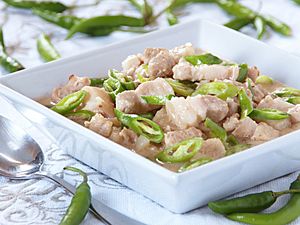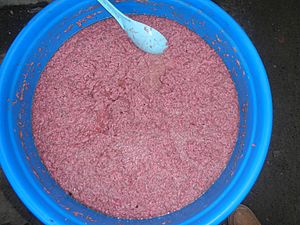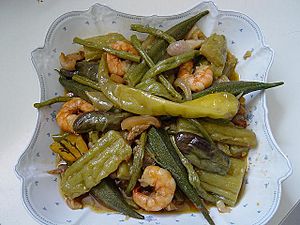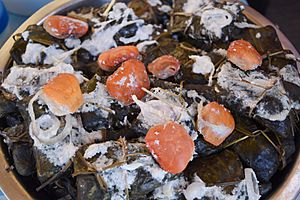Bicol Express facts for kids
 |
|
| Alternative names | Sinilihan |
|---|---|
| Type | Stew |
| Course | Main |
| Place of origin | Philippines |
| Region or state | Bicol |
| Created by | Cecila Kalaw |
| Main ingredients | Long chilies, coconut milk, shrimp paste or stockfish, onion, pork, garlic, ginger |
| Variations | Inulukan, Ginataang Isda, Laing, Pinakbet, gulay na may lada, Pinangat, Dinamita, Gising-gising |
Bicol Express is a super popular Filipino dish that's famous for its spicy and creamy taste. It's known in the Bikol language as sinilihan, which means spiced with chili. This yummy stew is made with long chili peppers (called siling haba) or small, super hot ones (siling labuyo). It also has rich coconut milk or cream, shrimp paste, onion, pork, ginger, and garlic.
The dish got its name from Cely Kalaw, a cook from Laguna. She named it during a cooking contest in the 1970s in Malate, Manila. The name was inspired by the Bicol Express train (Philippine National Railways) that traveled from Manila to Legazpi, Albay in the Bicol Region. Before it was called Bicol Express, people in the Bicol Region often called a similar dish gulay na may lada, which is a vegetarian version. Over time, many different types of Bicol Express have been created, including versions with seafood, beef, and even vegan options!
Contents
What's in a Name?
The name "Bicol" comes from old Spanish spellings, which later mixed with English. Spanish speakers sometimes used different letters like 'V' or 'B' because they sounded similar to them.
The Story of Bicol Express
How the Dish Started

The Bicol Express dish got its official name from Cely Kalaw. She was from Laguna and created the dish for a cooking contest in the 1970s in Malate, Manila. Her customers loved spicy food, so she made this new, hot Taro dish.
While she was trying to think of a name, Cely's brother heard the Philippine National Railway train passing by her restaurant. This gave her the idea to name the dish "Bicol Express," just like the train that went from Manila to the Bicol region.
Before Cely Kalaw named it, a very similar dish was already popular in the Bicol Region. It was called 'gulay na may lada'. This older version was vegetarian and had all the same ingredients as Bicol Express, but without meat like pork or shrimp paste. Cely Kalaw grew up in the Bicol Region, so she knew a lot about Bicolano cooking. This knowledge helped her create the Bicol Express dish we know today.
In the 1960s, people in the Bicol Region were already making and selling this dish, even without a formal name. Bicolanos would sell it to train passengers at the Sipocot station in Camarines Sur. They would put the dish in plastic bags and wrap the rice in taro leaves, making it easy to sell. But later, selling food on trains was stopped, and the dish became less common. That is, until Cely Kalaw brought it back and made it famous in her restaurant in Malate, Manila.
Why Bicol Loves Chili and Coconut
Coconuts and chili peppers are super important ingredients in dishes from the Bicol community. Both of these ingredients grow naturally and are very common all over the Bicol Region. There are more than 50 million coconut trees in Bicol, making it the top region in the Philippines for coconuts. The area also has the perfect wet weather for growing them.
The Siling labuyo (a small chili pepper) is used a lot in Bicolano cuisines. The spiciness of chilies is measured on the Scoville scale. A siling labuyo can be 100,000 SHU (Scoville Heat Units) hot, while a siling haba is about 50,000 SHU. The siling labuyo from Bicol is even spicier than the ones found in Manila! Spanish settlers brought these chili peppers to the Philippines a long time ago.
How to Make Bicol Express

To make the original Bicol Express, you'll need oil, ginger, garlic, onion, pork chunks, coconut cream or milk, siling haba (long chili peppers), bagoong alamang (shrimp paste), and rice on the side.
First, heat oil in a pan. Chop the garlic, onion, and ginger into small pieces. These three ingredients are cooked for about three minutes. Then, add the pork chunks and cook them until they turn brown. The pork is what makes the original Bicol Express special and different from other versions.
After the pork is brown, pour in the coconut cream or milk and let it simmer for a few minutes on low heat. Next, soak the siling haba in salted water for 30 minutes, then drain and cut them into 1-inch slices. Add them to the pan. Siling haba is often used because it's less spicy than siling labuyo, making the dish enjoyable for more people. However, in the Bicol Region, they often use the super spicy siling labuyo because locals are used to the heat!
The last ingredient is bagoong alamang (shrimp paste). In Bicol, people catch small shrimp (called alamang) with cast nets and then ferment them to make bagoong alamang. This special shrimp paste is not just for seasoning; it's the "base of the sauce" for Bicol Express, making its flavors really rich.
Bicol Express is served hot with a bowl of rice. Rice is a very important part of Filipino cuisine and completes the meal.
Different Kinds of Bicol Express
Seafood Bicol Express
There are many Bicol Express dishes that use seafood. Instead of pork, you can use fish (like tilapia), crab, manta rays, shark, or shrimp. This changes the taste and texture. All these versions are still served with hot rice.
One example is Ginataang Tilapia or Ginataang Isda. Here, tilapia is boiled in coconut cream and vinegar, mixed with siling labuyo, onion, and garlic. The vinegar gives it a sour taste, which is different from regular Bicol Express with tilapia.
A unique seafood version is Kinunot na Pating, or just Kinunot. This dish is like Bicol Express, but instead of pork, it has pieces of shark or manta ray meat. It gives the dish a different texture and a more exotic feel.
Inulukan is another variant that uses river crabs instead of pork. All the ingredients are wrapped in a taro leaf bundle and then cooked in coconut cream.
Beef Bicol Express
Beef can also be used instead of pork in Bicol Express. The cooking process is the same as the original. While beef might not be as tender as pork, it cooks faster.

Pescatarian Bicol Express
Pinakbet is a pescatarian (meaning it includes fish but no other meat) option similar to Bicol Express. This dish comes from the Ilocano community. They use Vegetables like bok choy (pechay) and sweet potato shoots (camote tops) instead of pork. It also includes alamang (shrimp) in the sauce to boost the flavors.
Vegetarian Bicol Express
Gulay na may lada is the oldest known vegetarian version of Bicol Express. It's made using traditional cooking methods from the Bicol Region.
Vegan Bicol Express
Bicol Express can even be made vegan! For this, tofu replaces the pork, and shiitake mushrooms are added to keep the texture similar. Vegetable paste and gluten-free soy sauce are used instead of bagoong alamang to create the rich flavors of the sauce.
Other Bicol Express Styles
Another famous Bicol dish, Pinangat (or Laing), is very similar to the original Bicol Express recipe, but it doesn't have onions. All the ingredients for Pinangat are wrapped in taro leaves and cooked in coconut cream.
Is Bicol Express Healthy?
Bicol Express has good things and not-so-good things for your body. It can be high in saturated fats and cholesterol, so it might not be the best choice if you're trying to lose weight. However, the siling labuyo in the dish gives you lots of vitamin C, iron, and magnesium. In the Philippines, siling labuyo has even been used as a home remedy for toothaches. Bicol Express is also a great source of protein, which is very good for your body. A serving of Bicol Express (about 246 grams) has around 308 calories, with about half of those calories coming from fats.
Making Bicol Express for Sale
Today, thanks to new technology, Bicol Express can be stored and sold more easily than in the past. In 2012, the Llaguno family started putting Bicol Express into glass jars. The Philippines' Department of Science and Technology helped them make these jars of Bicol Express last for a whole year! This helped the dish become even more popular and available everywhere.
See also
 In Spanish: Bícol exprés para niños
In Spanish: Bícol exprés para niños



